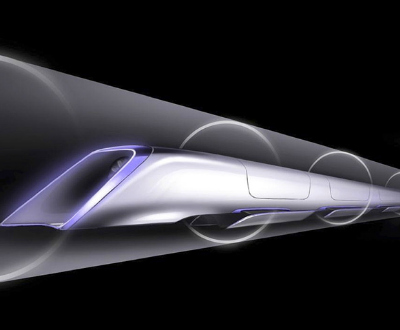
Two SJSU experts — a mechanical engineering professor and a transportation expert — comment on Elon Musk’s latest transportation venture (image courtesy of Tesla Motors).
Posted July 19 by the Silicon Valley Business Journal.
By Preeti Upadhyaya
All week, the buzz around the proposed Hyperloop transport system has been growing steadily as the world tries to figure out just how commuters are supposed to get between San Francisco and Los Angeles in 30 minutes.
In typical Elon Musk build-the-suspense fashion, the Tesla Motors and SpaceX CEO will make us wait until Aug. 12 to reveal plans for his ultra-fast transport system. That leaves us plenty of time to speculate about the feasibility of this potentially transformational idea.
So far, most experts theorize that Musk will employ a pneumatic tube system to make the Hyperloop a reality, though he has denied this on Twitter. Think of the plastic cylindrical container you use to transport documents at a drive up bank teller and you’ve got the basic idea.
This isn’t exactly a new concept, said Phil Kesten, a physics professor at Santa Clara University.
“You’d have trains, kind of like bullets, shooting up and down a tube,” said Kesten, who explained that friction would be minimized through a magnetic levitation system keeping the sides of the train from hitting the tube.
After some quick number crunching, Kesten calculated that a Hyperloop train would have to accelerate at a rate of 0.3 Gs for at least 15 minutes to live up to Musk’s promise of a SF to LA commute of 30 minutes. To put that into perspective, when a regular commercial airplane takes off, passengers experience 0.2 G, but for a very short period of time.
“After 15 minutes at 0.3 G, I suspect most of us wouldn’t be very happy,” Kesten said.
Kesten estimated that to make the Hyperloop work, the train would have to move at a peak speed of 5,000 miles an hour. That’s about 10 times the speed of a commercial jet.
While it may be physically uncomfortable, the Hyperloop is not theoretically impossible, said Burford Furman, a professor in the department of mechanical and aerospace engineering at San Jose State University.
“There’s nothing here that violates fundamental physics,” said Furman, who is an expert in the area of automated transit networks.
Furman explained that if you use automated transit technology as a model for how the Hyperloop would unfold, the issue of cost will inevitably pose a big roadblock.
“The big costs are in the guideway, the thing that supports and guides the trains. And the larger the structure, the more it costs,” he said.
Until we learn more from Musk himself, it will be difficult to reconcile this issue with his statement that the Hyperloop could be built at one-tenth the cost of California’s proposed high-speed rail system.
The cost would be “at least on the order of what it would take for high-speed rail,” said Furman. “It would probably go beyond that because this technology hasn’t been proven yet. High-speed rail and that technology exists already all over the world.”
High-speed rail in California itself is an embattled project, facing severe scrutiny and criticism for its cost, environmental impact and a host of other factors.
But at least the ball is rolling for that effort, said Rod Dirdon, executive director of the Mineta Transportation Institute, a San Jose-based research institute focusing on intermodal surface transportation issues.
Diridon said that Musk and his Hyperloop face an uphill battle in terms of securing project clearance.
That would have to come after extensive engineering studies and tests. Diridon said Musk must create a complete concept, build a test track, build a demonstration track to work out the kinks and acquire federal safety certifications as well as environmental clearance.
Only after that is complete can the project move forward with public hearings and obtaining land use rights from cities.
Diridon paints a dizzying picture of the red tape and bureaucracy that has mired the high-speed rail project in California.
The initial efforts to get environmental clearance started in 1996 and took until 2008 to approve only the route, station locations and mode of transport. Even then, the bullet train only has project clearance for the portion of the Central Valley, Diridon said.
Elon Musk would be building his Hyperloop from scratch with no prior models to draw on at the scale he is envisioning. Diridon suggested the time frame for the Hyperloop would be at least that of the high-speed rail project, and that’s being extremely generous.
While the challenges facing Hyperloop may be discouraging, Diridon stressed that he is supporting Musk’s efforts and anyone else who is looking at solutions beyond our current transport system.
“I’d do anything in the world to help this get beyond the institutional barriers in the way,” Diridon said. “But it will take a whole lot of effort to make it to primetime.”

